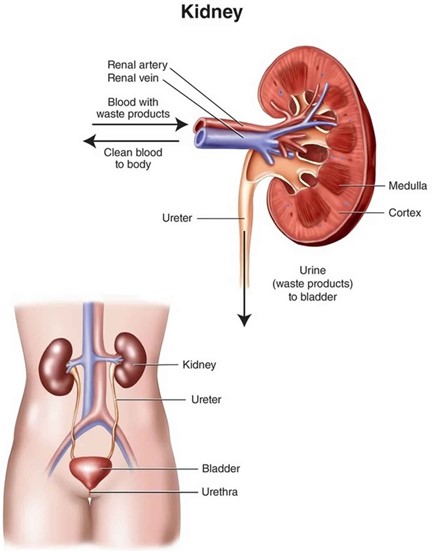The nurse is developing an educational program for older clients who are being discharged with new antihypertensive medications.
The nurse should ensure that the educational materials include which characteristics? (Select all that apply.).
Contains a list with definitions of unfamiliar terms.
Written at a twelfth-grade reading level.
Uses common words with few syllables.
Uses pictures to help illustrate complex ideas.
Printed using a 12-point type font.
Correct Answer : A,D
Choice A rationale:
The educational materials should contain a list with definitions of unfamiliar terms because older clients may not be familiar with medical terminology. Providing definitions can enhance their understanding of the new antihypertensive medications and promote medication adherence.
Choice B rationale:
Writing materials at a twelfth-grade reading level may not be appropriate for older clients. Many older individuals may have lower literacy levels, and using complex language can lead to confusion and hinder comprehension. Simple and clear language is more effective in educating this population.
Choice C rationale:
Using common words with few syllables is important for ensuring that older clients can easily understand the educational materials. Complex language and lengthy words can make it difficult for them to grasp important information about their antihypertensive medications.
Choice D rationale:
Using pictures to help illustrate complex ideas is essential when educating older clients. Visual aids can enhance comprehension and retention of information, especially for individuals who may have cognitive impairments or difficulty with written text.
Choice E rationale:
Printing materials using a 12-point type font is important for ensuring that the text is easy to read for older clients. Smaller fonts can be challenging for individuals with visual impairments, and readability is crucial for effective education.
Nursing Test Bank
Naxlex Comprehensive Predictor Exams
Related Questions
Correct Answer is C
Explanation
The correct answer is choicec. Administer prescribed stool softener.
Choice A rationale:
Administering prescribed PRN sleep medications can help the client rest, but it is not the highest priority. Managing pain and preventing complications from the laceration are more critical.
Choice B rationale:
Encouraging the use of prescribed analgesic perineal sprays can help manage pain and promote healing, but it is not as crucial as preventing constipation, which can cause significant discomfort and complications.
Choice C rationale:
Administering prescribed stool softeners is the highest priority because a fourth-degree laceration involves the anal sphincter and rectal mucosa.Preventing constipation is essential to avoid straining during bowel movements, which can cause pain and disrupt the healing process.
Choice D rationale:
Encouraging breastfeeding to promote uterine involution is important for postpartum recovery, but it is not directly related to the care of a fourth-degree laceration. Managing pain and preventing complications from the laceration take precedence.
Correct Answer is D
Explanation
This is the correct answer because BUN and creatinine are the most important laboratory values to monitor for nephrotoxicity, which is the damage or injury to the kidneys caused by certain drugs or chemicals.
Nephrotoxicity can impair the kidneys' ability to filter waste products from the blood, resulting in elevated levels of BUN and creatinine. The normal range for BUN is 7 to 20 mg/dL, and for creatinine is 0.6 to 1.2 mg/dL. The practical nurse (PN) should review these values before administering an antibiotic that can cause nephrotoxicity, such as aminoglycosides, cephalosporins, vancomycin, or sulfonamides. The PN should also monitor the client for signs and symptoms of nephrotoxicity, such as decreased urine output, edema, hypertension, fatigue, nausea, and confusion.
a) Serum calcium
This is not the correct answer because serum calcium is not directly related to nephrotoxicity. Serum calcium is the amount of calcium in the blood, which is important for bone health, muscle contraction, nerve function, and blood clotting. The normal range for serum calcium is 8.5 to 10.2 mg/dL. Serum calcium may be affected by kidney disease, but it is not a reliable indicator of nephrotoxicity.
b) Hemoglobin and hematocrit
This is not the correct answer because hemoglobin and hematocrit are not directly related to nephrotoxicity. Hemoglobin is the protein in red blood cells that carries oxygen, and hematocrit is the percentage of red blood cells in the blood. The normal range for hemoglobin is 13.5 to 17.5 g/dL for men and 12 to 15.5 g/dL for women, and for hematocrit is 38.8 to 50% for men and 34.9 to 44.5% for women.
Hemoglobin and hematocrit may be affected by kidney disease, but they are not reliable indicators of
nephrotoxicity.
c) White blood cell count (WBC)
This is not the correct answer because WBC is not directly related to nephrotoxicity. WBC is the number of white blood cells in the blood, which are part of the immune system and fight infections. The normal range for WBC is 4,500 to 10,000 cells per microliter of blood. WBC may be elevated in response to an infection or inflammation, but it is not a reliable indicator of nephrotoxicity.

Whether you are a student looking to ace your exams or a practicing nurse seeking to enhance your expertise , our nursing education contents will empower you with the confidence and competence to make a difference in the lives of patients and become a respected leader in the healthcare field.
Visit Naxlex, invest in your future and unlock endless possibilities with our unparalleled nursing education contents today
Report Wrong Answer on the Current Question
Do you disagree with the answer? If yes, what is your expected answer? Explain.
Kindly be descriptive with the issue you are facing.
